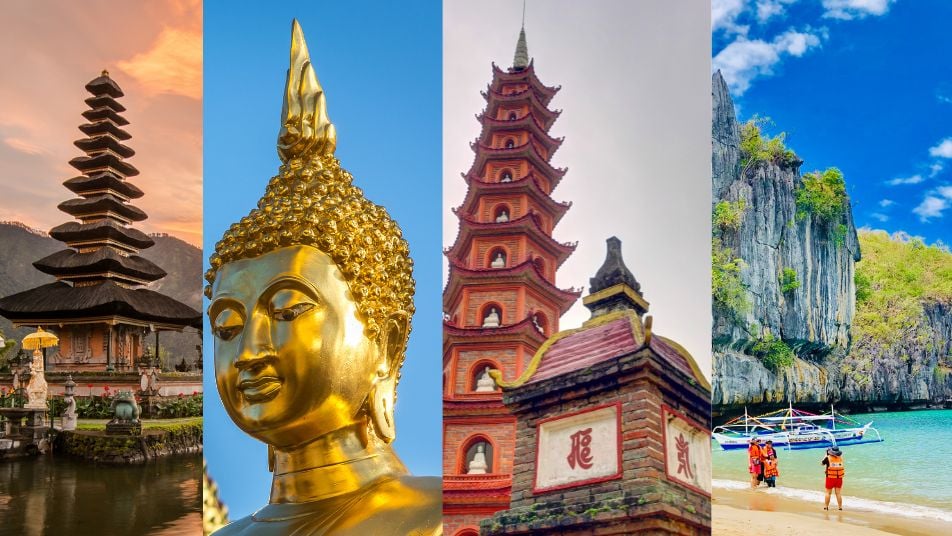Bali vs Thailand, Vietnam, and the Philippines: Which Southeast Asian Destination Is Best for Travelers in 2025?
by Dijiwa Sanctuaries

Which Is the Best Southeast Asian Travel Destination in 2025?

Bali, Thailand, Vietnam, and the Philippines are set to pamper travelers even more in 2025. Visa regulations are becoming more relaxed, entry procedures are getting simpler, and digital services are increasingly comprehensive. However, each destination has its own distinct style—from tourism taxes to etiquette at sacred sites.
This article offers a concise and engaging comparison of the latest policies, transportation access, cultural norms, and digital trends that travelers should know. Everything is presented in a clear and friendly tone, making it perfect for those planning a vacation or considering remote work from a tropical paradise.
Visa & Entry Rules 2025: Comparing Bali, Thailand, Vietnam, and the Philippines
1. Entry Policy and Tourist Tax in Bali
Foreign tourists who are not citizens of ASEAN countries can obtain a Visa on Arrival (VOA) upon arrival in Bali. This visa is valid for 30 days and costs approximately IDR 520,000. Citizens of ASEAN countries—including the Philippines, Thailand, and Vietnam—are exempt from visa requirements. Additionally, the Bali Provincial Government imposes a tourist levy of IDR 150,000 (around USD 10), which can be paid online before arrival. While travel insurance is not mandatory, it is strongly recommended.
2. Visa-Free Access and Digital Entry Rules in Thailand
Thailand has extended its visa-free stay to 60 days for passport holders from 93 countries to encourage longer visits. Starting May 2025, all travelers will be required to complete a Digital Arrival Card online at least 72 hours before arrival. Although the government previously planned to introduce a THB 300 tourism tax, the implementation has been temporarily postponed. For travelers from countries not included in the visa-free list, tourist visas and VOA options remain available.
3. E-Visa and Entry Requirements for Travelers to Vietnam
Vietnam offers visa-free entry to passport holders from approximately 25 to 30 countries, including ASEAN and several European nations. The length of stay ranges from 14 to 90 days, depending on the country of origin. Travelers from other nations can apply for a single-entry e-visa valid for 30 days via the official online platform, for a fee of around USD 25. Currently, there are no requirements for travel insurance and no departure tax for foreign visitors.
4. Tourist Entry, E-Visa, and Digital Nomad Visa in the Philippines
Most international travelers can enter the Philippines without a visa for stays of up to 30 days, provided they hold a valid exit ticket. An e-visa system has been introduced for select nationalities, including those from China, India, South Korea, and Japan. The country does not impose a departure tax on short-term visitors. Furthermore, the Philippines has launched a Digital Nomad Visa, valid for one year with an option to extend, and is currently developing a VAT refund scheme for foreign tourists.
Transportation and Travel Infrastructure in Southeast Asia: Which Country Wins?
When planning a trip to Southeast Asia, understanding how each country supports traveler convenience through transportation and digital infrastructure is essential. The four major destinations—Bali (Indonesia), Thailand, Vietnam, and the Philippines—all offer modern international airports, extensive domestic networks, and expanding online services, although the efficiency and scale of these systems vary.
1. Airport, Local Transport, and Digital Services in Bali
Ngurah Rai International Airport in Bali now features automated biometric passport gates, expediting immigration processes for travelers. For exploring other parts of Indonesia, there is a network of domestic flights and inter-island crossings. However, public transportation remains limited. Travelers often rely on scooters or rental vehicles, which require caution due to narrow, congested roads. Ride-hailing services are widely available and commonly used in tourist areas, offering added convenience.
2. Thailand’s Superior Transit System and Digital Tourism Innovation
Thailand boasts the most comprehensive transportation infrastructure in the region. Bangkok is served by two major international airports and features a highly efficient urban transit system, including the BTS Skytrain and MRT. High-speed rail projects are currently underway to enhance interregional connectivity. In addition, domestic flights and fast boats provide easy access to popular destinations such as Chiang Mai, Phuket, and Koh Samui. Thailand also offers the Destination Thailand Visa (DTV), allowing stays of up to 180 days—ideal for long-term travelers and remote workers.
3. Vietnam’s Expanding Infrastructure for Travelers
Vietnam is steadily expanding its air, rail, and highway systems. Key international airports such as Noi Bai (Hanoi) and Tan Son Nhat (Ho Chi Minh City) serve as major gateways. The development of Long Thanh Airport near Ho Chi Minh City reflects Vietnam’s long-term investment in transportation infrastructure. Domestically, low-cost airlines, conventional trains, and a robust 4G/5G network ensure solid mobility and digital connectivity. Although Vietnam does not offer a specific visa for digital nomads, many long-term travelers opt for business visas.
4. Inter-Island Travel, Airports, and Internet Access in the Philippines
The Philippines supports inter-island travel through a vast network of domestic airports and ferry routes. Major airports—including Manila’s Ninoy Aquino International Airport (NAIA), currently expanding with the new Terminal 3—along with Cebu and Clark, accommodate growing numbers of international flights. While infrastructure and traffic remain challenges, the country is becoming increasingly attractive to remote workers, thanks to the renewable one-year Digital Nomad Visa (DNV). Fast internet and coworking spaces are available in Metro Manila, Cebu, and various tourist hubs.
Cultural Etiquette and Local Customs: What Travelers Should Know
Southeast Asian countries that are popular among international travelers—such as Indonesia (Bali), Thailand, Vietnam, and the Philippines—are not only known for their natural beauty and rich cultures, but also for the importance they place on respectful behavior and adherence to local customs. Visitors are encouraged to learn and observe cultural norms, especially when visiting sacred or religious sites.
Dress Rules for Visiting Temples and Churches in Southeast Asia
Respectful attire is expected at temples, churches, and other religious sites throughout the region:
- Bali (Indonesia): When visiting Hindu temples, tourists must wear a sarong and cover their shoulders. Entry may be denied to those wearing revealing clothing, though sarongs are often available for rent or provided at the entrance.
- Thailand: Similar standards apply at Buddhist temples and the Grand Palace in Bangkok. Clothing such as short skirts, sleeveless tops, or tight outfits is not permitted.
- Philippines: At Catholic churches like the Basilica Minore del Santo Niño in Cebu, visitors must cover their shoulders and knees. Shorts and revealing clothing are strictly prohibited in some churches.
- Vietnam: While generally more relaxed, modest dress is still recommended at temples and pagodas as a gesture of respect.
Common Cultural Mistakes to Avoid in Southeast Asia
- Footwear: Removing shoes before entering homes, temples, and certain business premises is customary in both Bali and Thailand.
- Feet Etiquette: In Bali, it is considered highly disrespectful to point with one’s feet or to direct the soles of the feet toward another person or a religious altar.
- Offerings in Bali: Tourists should avoid stepping on canang sari, the daily offerings placed on the ground as part of local Hindu rituals.
- Public Displays of Affection: In Bali, Thailand, and more conservative regions of the Philippines, public displays of affection (e.g., kissing or hugging) are generally frowned upon and should be kept to a minimum.
- Thailand enforces strict lèse-majesté laws. Making negative remarks about the royal family—whether in person or online—can result in serious legal consequences, including imprisonment.
- Vietnam, while lacking a royal family, advises caution when discussing political topics or the country’s historical conflicts, especially in public settings.
- Religious Sensitivity: In the Philippines, a predominantly Catholic nation, respect for religious values and symbols is expected both inside places of worship and in everyday conversations.
Laws Tourists Must Know: Penalties in Bali, Thailand, Vietnam, and the Philippines
Despite their reputations as tourist-friendly destinations, Southeast Asia’s most popular travel spots enforce strict legal restrictions on certain behaviors. Travelers should be aware that drug-related offenses, acts of vandalism, and disrespect toward cultural norms are taken seriously and can lead to severe penalties.
Drug Laws Comparison: Zero Tolerance Policies in Southeast Asia
All four countries—Indonesia, Thailand, Vietnam, and the Philippines—maintain a strict, zero-tolerance stance on drug-related offenses:
- Indonesia enforces the death penalty for serious drug crimes. Police often remind foreign visitors that the country's drug laws are strict and long-standing.
- Thailand and The Philippines impose harsh prison sentences for drug smuggling, distribution, and in some cases, even possession.
- Vietnam, though less publicly known for its enforcement, also carries strict criminal penalties for significant quantities of illegal drugs.
Fines and Offenses Tourists Should Avoid
In addition to drug laws, these countries have regulations aimed at protecting their culture, environment, and public order:
- Littering, vandalizing temples, or misusing national symbols can result in fines and legal action.
- In Vietnam, insulting national emblems or symbols is considered a serious criminal offense.
- Bali (Indonesia) has implemented a ban on single-use plastics, particularly in tourist-heavy areas. Violators may face environmental fines.
- In the Philippines, smoking in public spaces—especially in urban areas—is strictly regulated.
- Although a relaxed lifestyle is generally accepted, behavioral adjustments are expected, especially in:
- Dressing modestly in places of worship
- Removing shoes when entering homes or temples
- Showing respect toward religious and royal symbols
Local Norms in Tourist Hotspots: Ubud, Kuta, Chiang Mai, Boracay, and More
Tourist expectations can vary not only between countries but also within regions of each country. Local norms may significantly affect the behavior expected of travelers.
Travel Etiquette Differences in Bali: Ubud vs Kuta
- Ubud, Bali’s spiritual and cultural heart, holds strict standards of modesty. Temple visitors are required to wear sarongs and scarves. Women may be restricted from entering sacred sites during menstruation or pregnancy, in accordance with local customs.
- Kuta and Seminyak, on the other hand, are more relaxed. Swimwear and casual attire are common in resorts and beach areas. However, modest clothing is still recommended when leaving tourist zones.
Dress Codes and Customs in Thailand’s Tourist Zones
- In Bangkok, iconic sites like the Grand Palace and Wat Phra Kaew enforce strict dress codes: shorts and sleeveless tops are prohibited.
- Chiang Mai, a northern temple town, also encourages modest dress but tends to be more relaxed and less crowded.
- Conversely, nightlife areas such as Khao San Road and Patpong have virtually no dress restrictions, reflecting a free-spirited party culture.
Etiquette in the Philippines: From Churches to Coastal Towns
- In cities like Cebu and Manila, historical churches such as the Basilicadel Sto. Niño or those in Intramuros require modest attire. Revealing clothing and shorts are typically not permitted.
- Public spaces such as markets and tourist spots nearby have no specific dress code, though polite behavior is still expected.
- In beach areas like Boracay and Palawan, swimwear is allowed on beaches and in resort areas. However, local rules may require covering up when leaving the beach, although enforcement is generally lenient.
Tourism Infrastructure Comparison: Bali vs. Thailand, Vietnam, and the Philippines
As post-pandemic tourism competition intensifies, four leading Southeast Asian destinations—Thailand, Indonesia (Bali), Vietnam, and the Philippines—are striving to attract visitors through a combination of digital innovation, policy incentives, and enhanced entry services. The year 2025 marks a new era for travel in the region: more accessible, more connected, and increasingly tailored to the modern traveler.
Smart Travel 2025: How Digital Services Are Shaping Tourism
Thailand is leading the digital transformation of tourism. The Tourism Authority of Thailand (TAT) has partnered with the popular ride-hailing app Grab to offer travel promotions and local guides across all 55 provinces. The country’s official tourism website is widely regarded as the most comprehensive and user-friendly, featuring a digital arrival form and a streamlined e-visa system.
Vietnam is making similar progress. Its official portal, vietnam.travel, provides multilingual content and offers e-visas for many nationalities—without the need for agents or physical paperwork. In major cities such as Ho Chi Minh City and Hanoi, services like public Wi-Fi, online booking, and digital maps are readily available.
The Philippines is rapidly catching up. The government has launched the PhilippineTravelGov platform, along with an e-visa system and an online VAT refund service—all of which have been well received by international visitors. Internet connectivity is strong in urban centers like Manila and Cebu, although it remains inconsistent in remote areas.
Bali Indonesia, particularly Bali, features the official LoveBali website, which now supports online payment of tourism taxes. Travel information is widely available via blogs, maps, and booking platforms. However, digital navigation is less streamlined due to fragmentation across government, private, and third-party websites.
Best Digital Nomad Visa Options in Southeast Asia
These destinations are now offering more than beautiful beaches and vibrant cultures—they are also appealing to long-term travelers and digital nomads through favorable visa policies:
- Thailand has extended its 60-day visa exemption for many nationalities and introduced the Destination Thailand Visa (DTV) for remote workers, positioning itself as one of the most progressive countries in the region.
- Indonesia offers the E33G digital nomad visa, which allows remote workers to stay in Bali for up to one year without paying domestic taxes, provided their income is earned abroad. Revenue from Bali’s new tourism tax is earmarked for conservation and infrastructure improvements.
- Vietnam has extended its visa-free policy for several Western nations through 2028 and is expediting the e-visa process, making it easier for long-stay travelers.
- The Philippines, through Executive Order No. 86, introduced the Digital Nomad Visa (DNV) and expanded its e-visa services to cover more Asian countries. Additional benefits include no departure tax for short visits and VAT refunds for shopping tourists.
Conclusion: Which Destination Is More Traveler-Friendly in 2025?
With ongoing technological upgrades and supportive policies, Southeast Asia is not just rebounding from the pandemic—it’s reinventing itself for a new generation of travelers: fast, flexible, and digitally connected.
To ensure a smooth and respectful journey, visitors are encouraged to familiarize themselves with local customs, dress codes, and religious etiquette. In the competitive tourism landscape of 2025, adaptability goes beyond convenience—it is the foundation for meaningful and enriching travel experiences.
Planning a trip to Bali? Discover serenity and soulful hospitality at Dijiwa Sanctuaries. From cultural immersion to nature-inspired wellness, it’s the perfect base for conscious travelers seeking more than just a vacation.


